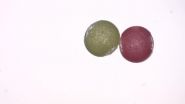(Press-News.org) Complementing the five basic tastes of sweet, bitter, salty, sour and umami, a large variety of odors also contribute to the overall sensory impression of a foodstuff. In recent decades, approximately 10,000 volatile food compounds have been identified. Scientists from Technische Universität München (TUM) and the German Research Center for Food Chemistry (DFA) have carried out a meta-analysis on the odorant patterns of 227 food samples.
How cognac gets its complex notes
They were surprised to find that the almost unlimited variety of food smells is based on 230 key odorants. In addition, each foodstuff has its own odor code comprised of a core group of between just 3 and 40 of the 230 key odorants – in specific concentrations. These small groups of odorous substances are what give all kinds of foodstuffs – from pineapple to wine to roast meat – their unmistakable aromas.
"So for example, the smell of cultured butter is encoded by a combination of just 3 key molecules, but fresh strawberries have 12," explains Prof. Peter Schieberle from the TUM Chair of Food Chemistry. Cognac is the most complex of all: the smell of this popular brandy is attributable to 36 key molecules.
Brain blends individual notes to create a new odor identity
The chemical odor codes are translated into olfactory stimulus patterns when food is consumed. For this, the key odorous substances have to interact with one or more of the 400 olfactory receptors in the nose. "A combination of between just few key odorants creates an authentic perception of odors. This is all the more surprising given that the olfactory quality of the combinations is not determined by the individual components," says Prof. Thomas Hofmann from the TUM Chair of Food Chemistry and Molecular Sensory Science.
When people perceive external chemical odor patterns and process them in the brain, the individual odor components do not just add up. Rather, the individual olfactory notes are translated into a new odor identity. "In view of the chemical odor code combination possibilities and the 400 or so different olfactory receptors, it appears that there is a more or less unlimited number of discernible odor qualities," claims Schieberle.
Optimizing odors in food production
So far, scientists have identified 42 receptors that respond to food odors – with the majority binding multiple odor molecules. "By mapping the odorous substances of the 230 currently known key odors, scientists can test which receptor combinations are 'reserved' for food odors," explains Hofmann. "This will help us explain the biological relevance of odors in even greater detail."
The mapping of odor codes opens up new possibilities for biotechnology applications. For example, knowing more about the odor codes of crop plants and fruits at molecular level can be useful to breeders. In the past, increasing yield and ground coverage had a much higher priority than sensory quality. The findings also lay the scientific groundwork for the next generation of aroma products, which use the potential of optimized biosynthetic pathways in plants for industrial-scale production of high-quality food odorants.
This latest odorant mapping will also enable more precise natural simulation of odors. This will bring us a step closer to new applications in mobile communication systems such as sending olfactory messages by smartphone or even the development of bioelectronic noses.
INFORMATION:
Publication:
Andreas Dunkel, Martin Steinhaus, Matthias Kotthoff, Bettina Nowak, Dietmar Krautwurst, Peter Schieberle and Thomas Hofmann; Nature's Chemical Signatures in Human Olfaction: A Foodborne Perspective for Future Biotechnology; Angewandte Chemie International Edition; DOI: 10.1002/anie.201309508
Contact:
Prof. Dr. Thomas Hofmann
Chair of Food Chemistry and Molecular Sensory Science
Tel.: +49 8161 71-2902
thomas.hofmann@tum.de
http://www.molekulare-sensorik.de/startseite.html
Decoding characteristic food odors
Scientists map molecular olfactory signatures of foodstuffs
2014-06-26
ELSE PRESS RELEASES FROM THIS DATE:
Treating gum disease improves vascular health in Indigenous Australians: Study
2014-06-26
A simple non-surgical gum disease treatment markedly reduces the thickness of the wall of the arteries, a risk factor for heart disease, according to a first of its kind study among Aboriginal Australians.
The study findings may be of particular importance to Aboriginal Australians, who in general have poorer oral health and higher rates of cardiovascular disease.
Published in the latest issue of Hypertension, the study reports a significant decline in thickening of the wall of the carotid artery a year after a single session of gum treatment.
"The study shows that ...
Increased nearsightedness linked to higher education levels and more years spent in school
2014-06-26
German researchers have found strong evidence that attaining a higher level of education and spending more years in school are two factors associated with a greater prevalence and severity of nearsightedness, or myopia. Published online this month in Ophthalmology, the journal of the American Academy of Ophthalmology, the research is the first population-based study to demonstrate that environmental factors may outweigh genetics in the development of myopia.
While common, nearsightedness has become even more prevalent around the world in recent years and presents a growing ...
Victoria's volcano count rises
2014-06-26
Geologists have discovered three previously unrecorded volcanoes in volcanically active southeast Australia.
The new Monash University research, published in the Australian Journal of Earth Sciences, gives a detailed picture of an area of volcanic centres already known to geologists in the region.
Covering an area of 19,000 square kilometres in Victoria and South Australia, with over 400 volcanoes, the Newer Volcanics Province (NVP) features the youngest volcanoes in Australia including Mount Schank and Mount Gambier.
Focusing on the Hamilton region, lead researcher ...
Shaken, not stirred -- mythical god's capsules please!
2014-06-26
VIDEO:
Two oil drops, covered with particles of different properties, coalesce due to the action of an alternating electric field, forming a Janus capsule.
Click here for more information.
Everything depends on how you look at them. Looking from one side you will see one face; and when looking from the opposite side – you will see a different one. So appear Janus capsules, miniature, hollow structures, in different fragments composed of different micro- and nanoparticles. Theoreticians ...
A versatile joystick for animation artists
2014-06-26
Remember those molecule models made from sticks and balls you could assemble to study complex molecules back in school? Something similar has taken shape in the Interactive Geometry Lab at ETH Zurich. ETH-professor Olga Sorkine-Hornung and her team do not study molecules but ways to manipulate virtual shapes, like animated characters on a computer screen. Now they have developed an input device or "joystick" to move and pose virtual characters, made up – similar to the molecule models – of modular building blocks. An artist can assemble these blocks into an approximate ...
US rich get richer on stock market investments while modest investors are left behind
2014-06-26
In a new study, researchers from Imperial College Business School, Columbia University and the University of Maryland found that wealthy individuals in the US can get in relative terms up to 70 per cent times greater returns on their investments than those with modest wealth, when the yields on assets such as stocks and bonds are calculated. The team say that this further widens the income gap between rich and poor and potentially creates disparities in society.
Income inequality in the US has been steadily rising. According to a report by Oxfam International released ...
DFG and Leopoldina: Recommendations on 'scientific freedom and scientific responsibility'
2014-06-26
The Deutsche Forschungsgemeinschaft (DFG, German Research Foundation) and the German National Academy of Sciences Leopoldina presented their joint recommendations on "Scientific Freedom and Scientific Responsibility" on 26 June 2014 in Berlin. Attended by representatives from the media, the Professors Jörg Hacker and Peter Strohschneider, Presidents of the Leopoldina and the DFG respectively, presented recommendations for handling security-relevant research, placing the subject against the background of the current political debate. With the publication the research organisations ...
Virus infection supports organ acceptance
2014-06-26
This news release is available in German. Over 150 million people throughout the world suffer from chronic infection with the hepatitis C virus (HCV), which causes massive damage to the liver. Advanced liver diseases often necessitate liver transplants. In the new clinical study Dr. Felix Bohne and his colleagues studied together with Prof. Alberto Sánchez-Fueyo from King's College London 34 hepatitis C patients at the Liver Unit of the University Hospital Clínic de Barcelona who had received new livers.
The researchers had two objectives here: first, they wanted ...
Fruit flies help scientists uncover genes responsible for human communication
2014-06-26
COLUMBIA, Mo. – The evolution of language in humans continues to perplex scientists and linguists who study how humans learn to communicate. Considered by some as "operant learning," this multi-tiered trait involves many genes and modification of an individual's behavior by trial and error. Toddlers acquire communication skills by babbling until what they utter is rewarded; however, the genes involved in learning language skills are far from completely understood. Now, using a gene identified in fruit flies by a University of Missouri researcher, scientists involved in ...
Early surgical follow-up with primary care physicians can cut hospital readmissions
2014-06-26
(SALT LAKE CITY)—Patients who have post-operative complications following high-risk surgery have a significantly lower risk of being readmitted to the hospital within 30 days if they go see their primary care physician soon following discharge, a new study in JAMA Surgery shows.
The study shows that better coordination of care between surgeons and primary care physicians is important to help reduce hospital readmissions within 30 days for those high-risk surgery patients who have post-operative complications or live with a chronic disease, according to Benjamin S. Brooke, ...
LAST 30 PRESS RELEASES:
What determines the fate of a T cell?
Candida auris: genetic process revealed which could be treatment target for deadly fungal disease
Groundbreaking discovery turns household plastic recycling into anti-cancer medication
Blocking a key inflammatory pathway improves liver structure and vascular function in cirrhosis, study finds
Continuous spread: Raccoon roundworm detected in nine European countries
HKUST Engineering researchers developed a novel photodetector to enhance the performance of on-chip light monitoring
Strategic river sensors could have forewarned of Texas Camp flood disaster
Drone sampling of whale breath reveals first evidence of potentially deadly virus in Arctic
Roman soldiers defending Hadrian’s Wall infected by parasites, study finds
Pinochet’s prisoners were tormented with music but still found solace in it, a new book reveals
Fertility remains high in rural Tanzania despite access to family planning
AI-assisted device can improve autism care access
Kinetic careers
Uncovering how parasitic plants avoid attacking themselves to improve crop resistance
Nanoparticle vaccine strategy could protect against Ebola and other deadly filoviruses
Study finds brain care score can predict risk of stroke across racial groups
Key lung immune cells can intensify allergic reactions
Do hormones explain why women experience more gut pain?
New materials conduct ions in solids as easily as in liquids
Breakthrough of the Year: Renewable energy begins to eclipse fossil fuel-based sources
LLM use is reshaping scientific enterprise by increasing output, reducing quality and more
Introducing LightGen, a chip for ultra-fast, ultra-efficient generative AI
Astronomers see fireworks from violent collisions around nearby star
ACC/AHA issue new guideline on managing congenital heart disease in adults
Cosmic crash caught on camera
Is talented youth nurtured the wrong way? New study shows: top performers develop differently than assumed
Ants: An untapped resource in the development of antibiotics?
Archaeologists use AI to create prehistoric video game
Mitochondria migrate toward the cell membrane in response to high glucose levels
Tiny viral switch offers hope against drug-resistant bacteria
[Press-News.org] Decoding characteristic food odorsScientists map molecular olfactory signatures of foodstuffs


